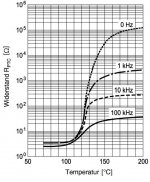Hi,
I want to protect the 1" HF horn ( 40W/8 Ohms ) of my bass guitar cabinet with a Polyswitch resettable fuse. If I have calculated well the result for my HF is 2.23A. Do I have to match this result with the trip current of the Polyswitch? The RXEF- 110 shows a 2.2A trip current : Digi-Key - RXEF110-ND (Manufacturer - RXEF110) .Is it the right one or do I have to choose another value ?: http://dkc3.digikey.com/PDF/US2010/P2107.pdf
Many thanks,
Pascalou
I want to protect the 1" HF horn ( 40W/8 Ohms ) of my bass guitar cabinet with a Polyswitch resettable fuse. If I have calculated well the result for my HF is 2.23A. Do I have to match this result with the trip current of the Polyswitch? The RXEF- 110 shows a 2.2A trip current : Digi-Key - RXEF110-ND (Manufacturer - RXEF110) .Is it the right one or do I have to choose another value ?: http://dkc3.digikey.com/PDF/US2010/P2107.pdf
Many thanks,
Pascalou
Yes, that's what's given by the calculator at Loudspeaker Protection Components
Ref #110Input instruction (a guide line according to our experience):
For
- PA tweeters half the the rated power handling should be entered
lautsprechershop
Be advised...
I used these in a couple builds, and it actually added an ohm of resistance to the design with it engaged and not preventing the current. You may need to lessen your L-pad a smidge.
Also- I would recommend placing a 12-15 ohm resistor in parallel with the Polyswitch so that you know the driver is okay when it interrupts the circuit. It will just strongly limit its output when engaged. After the polyswitch cools, the output will return to normal.
Later,
Wolf
I used these in a couple builds, and it actually added an ohm of resistance to the design with it engaged and not preventing the current. You may need to lessen your L-pad a smidge.
Also- I would recommend placing a 12-15 ohm resistor in parallel with the Polyswitch so that you know the driver is okay when it interrupts the circuit. It will just strongly limit its output when engaged. After the polyswitch cools, the output will return to normal.
Later,
Wolf
Wolf, can you - or anyone having experience too - please
say a word or two about "audibility" of polyswitches ?
Are there any effects before reaching the "trip current" ?
Is there any ageing noticeable, especially when switched
more often ?
Kind Regards
say a word or two about "audibility" of polyswitches ?
Are there any effects before reaching the "trip current" ?
Is there any ageing noticeable, especially when switched
more often ?
Kind Regards
Wolf, can you - or anyone having experience too - please
say a word or two about "audibility" of polyswitches ?
Are there any effects before reaching the "trip current" ?
Is there any ageing noticeable, especially when switched
more often ?
Kind Regards
I can't tell it's there, other than the reduced output. I have not tried it without on one of the 2 I've used them.
Don't know that either- I've never managed to trip one.
Later,
Wolf
Thank you Wolf,
i found some information on characteristics
of PTC resetable fuses, unfortunately the
text is in german language only:
http://www.controllersandpcs.de/lehrarchiv/pdfs/elektronik/pass01_04x.pdf
The rise in resistance between "normal" and "tripped"
state seems to be highly frequency dependent.
Especially in the tripped state, there is a capacitive
component.
Nevertheless the elements seem to be usable quite
well for the purpose, see attached picture ...
i found some information on characteristics
of PTC resetable fuses, unfortunately the
text is in german language only:
http://www.controllersandpcs.de/lehrarchiv/pdfs/elektronik/pass01_04x.pdf
The rise in resistance between "normal" and "tripped"
state seems to be highly frequency dependent.
Especially in the tripped state, there is a capacitive
component.
Nevertheless the elements seem to be usable quite
well for the purpose, see attached picture ...
Attachments
Last edited:
Quiet old thread but I use poly fuses in every speaker build. Haven’t noticed reduction in output up until tripping. So far zero tweeters blown. For what they cost every speaker manufacturer should use them.
These are designed to protect against an overload.
Once they have been driven into overload, they never reset to as new condition, instead the impedance at rest climbs and they will trip earlier as well.
So if tripped, replace them.
Once they have been driven into overload, they never reset to as new condition, instead the impedance at rest climbs and they will trip earlier as well.
So if tripped, replace them.
A polyswitch (a polymeric PTC device or PPTC) is intended to protect against occasional, accidental overloads.
Prolonged exposure to overload will cause failure of the polyswitch as described above and in the article below.
Resettable fuse - Wikipedia
Prolonged exposure to overload will cause failure of the polyswitch as described above and in the article below.
Resettable fuse - Wikipedia
Better replace tripped poly switch than $400 tweeter.
No? Increase in resistance can be heard on tweeter if you can hear it replace it.
No? Increase in resistance can be heard on tweeter if you can hear it replace it.
- Home
- Loudspeakers
- Multi-Way
- Polyswitch fuse for speaker protection
